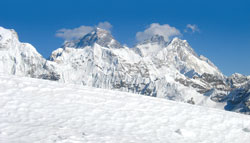|
|
| SEASON TICKET: The icy tripod of Chomolugma, Lhotse, and Nuptse as seen from Gokyo Valley last autumn. |
Together with warm weather and spring, mountaineers from around the world will also descend on Kathmandu in the next few weeks. Most teams this spring will attempt Chomolungma, either from the south side here in Nepal or from the north across the border in Tibet.
Last year was tragic-11 people lost their lives on Chomolungma-but that isn't deterring the regular stream of first-timers, mountaineering veterans, and individual climbers trying to put up new routes or aiming to do something special, like climbing half-blind, half-naked, or without arms or legs.
One of the major highlights for Nepal is the joint expedition of two heroic, record-breaking Sherpas. This year Apa Sherpa, who has stood on the top of the world 16 times, and Lhakpa Gelu, who holds the speed record of 10 hours, 56 minutes and 46 seconds from base camp to the top, want to draw more attention to the essential role of the Sherpas in the mountaineering world. The two Super Sherpas will climb via the South Col, on the route Tenzing Norgay and Edmund Hillary took on their first ascent in 1953.
Meanwhile, 50 Chinese mountaineers want to take the Olympic torch to the top from the north side. The China Tibet Mountaineering Association says this is a trial run for the 2008 torch ceremony ahead of the Summer Olympics.
Another expedition will have fewer people but will lug almost 22 tonnes of equipment through the Khumbu region to base camp. A British research expedition, led by high altitude clinician Mike Grocott, hopes to learn lessons from the parallels between the human body pushed to its limits in extreme environments, and during critical illness. The tests include experiments with an exercise bike and the first arterial blood samples taken on the summit. This could pose a problem, given the harsh, freezing conditions on the mountain.
But if the doctors are having trouble pushing needles through their own down suits, they could look out for Dutchman Wim Hof, who plans to climb from the Tibetan side wearing just boots, shorts, gloves, and a cap.
The Brisbane Times quoted expedition leader Werner de Jong as saying that Hof would not be scantily clad all the time, but that he was certainly out there to set a new record. The 47-year-old, also called the "Iceman," holds nine endurance records and recently ran 21km barefoot above the Arctic Circle in Finland. Hof says he has special abilities to withstand freezing temperatures.
Norwegian climber Cato Pedersen, who lost all of his left and half his right arm when electrocuted in 1973, wants to be the first person to summit Everest without arms. Pedersen, who calls his expeditions "Unarmed", has summitted two mountains so far, the last being Cho Oyo in autumn 2005. In 1994 Pedersen reached the South Pole with a 109kg sled, after skiing for 56 days over 1,545km.
British climber and fundraiser, Gavin Bate, is coming back to Everest for the fourth time. He got to 8,760m from the South in spring 2005, and now wants a bit of a challenge. Bate plans to traverse from the North to the South face taking 55 to 60 hours and without supplementary oxygen. Although he will be taking along Sherpas, he wants to climb Alpine style. "I will have with me a Nepalese Sherpa called Pasang Tendi, who will follow me and help me if I collapse or need assistance. He will be using oxygen but he will not be carrying any of my equipment," Bate says on his website. Before getting to Chomolungma, the 40-year-old climber plans to summit Cho Oyo, the world's sixth highest mountain.
More than 50 expeditions will share Base Camps on both sides of Everest. Last year more than 450 people reached the top. According to the Himalayan Database, compiled by climbing chronicler Elizabeth Hawley and Richard Salisbury, there have been 3,045 successful ascents of Everest (some people have summitted more than once).
Chomolungma is by no means the only peak climbers will tackle in Nepal this spring. At 8,091m Annapurna I may only be the 10th highest mountain in the world, but it is one of the most treacherous and avalanche-prone peaks. Experienced, respected climbers, including Anatoli Boukreev from Kazakhstan, have died in fatal avalanches on it.
This year Swiss climber Ueli Steck will have a crack at the South Face of Annapurna I, a route first climbed by a 16-member British team in 1970. That expedition, under the leadership of Chris Bonington, used supplementary oxygen and fixed about 2,500m of rope.
Steck, who set a new speed record on Eiger's North Face in Switzerland in February, sees this sheer face as one of the major challenges in Himalayan climbing. "Until now nobody has been able to solo this steep and technically difficult face but I am prepared and ready to take up that challenge," he writes on his website.



